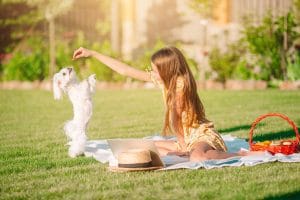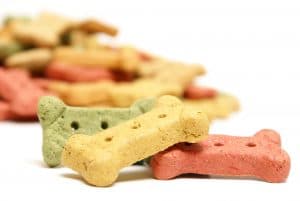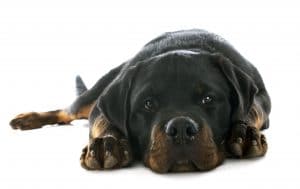![]()
HeelBoyHeel is reader supported. When you buy through any link on our site, we may earn an affiliate commission, but never at any extra cost to you.
Puppies are cute, cuddly and fun to play with. They also require a lot of attention and training to become well-behaved pets. The puppy training process will take time!

It is not always easy to care for a puppy when you first bring it home. Although a small puppy will probably not bark initially, it may nip (with needle-sharp baby teeth!) and have “unfortunate toilet accidents” in the house. Setting up a good relationship with your puppy from day 1 can help to quickly restore some order to your household.
In this article, we will discover the 10 first things to train a puppy to start on a process that will result in this cute bundle of random energy transformed into a well behaved, happy and loyal companion.
1. Teach Your Puppy His or Her Name
The first thing you should teach your puppy is his or her name, it’s a good idea to do this as soon as possible after collecting him or her from the breeder. Most people will have decided on a name for their puppy soon after deciding to get one. However, if you have not already chosen a name, these are a few things to consider.
Choose a name that you and other members of the household like and will easily remember. Be consistent with the name chosen. If someone you socialise with regularly also has a dog, don’t choose the same name. Most puppies respond to the ending of their name, so if your sister, for example, has a dog called Charlie, avoid names like Marley. Why not try Marco?
Use your puppy’s name as much as possible when talking and playing with him or her. If you have to discipline your puppy, don’t use the name. You want the puppy to be happy to hear his or her name. When he or she responds to the new name cuddles and praise are the order of the day.
2. Potty Training Your Puppy

A potty-trained pup is something you will want as soon as possible. Depending on how old your puppy is when you take it to it’s new home will very much depend on how quickly this can be achieved. A very young puppy, for example 6 weeks, will not have full control of his or her bladder yet. Even if your new puppy is older, you must be prepared for “accidents”. Time, patience and consistency are definitely required.
When arriving home with the new puppy, introduce him or her to the water bowl, living quarters and where he or she will be expected to go to the toilet. Inside your home it is best to restrict your new puppy to an area where “accidents” can be cleared up easily.
Initially, take your puppy outside to where you want it to go to the toilet as regularly as possible and especially before you leave the puppy by itself inside. The puppy will prefer an area with grass or soil to a solid surface such as concrete or tiles. If he or she goes to the toilet in the correct area, praise and cuddles are definitely due! However, when “accidents” happen inside the home it should be cleaned up without getting upset with the puppy.
3. Playing With Your Puppy
Once your puppy has become accustomed to his or her new surroundings, it will be time to play! A puppy learns through play. So, a fun game becomes a training session! It is a great way to teach your puppy his or her name and gently introduce him or her to basic commands such as “Sit”, “Stay” and “Come”. Don’t expect immediate results, training takes time and consistency.
You will need to have appropriate toys for your puppy – things to chase after and to chew. Your puppy will want to chew things as the puppy teeth are replaced by the adult teeth. By providing toys, you may avoid the puppy chewing the furniture, etc.
When playing with your puppy, please take into account that a young puppy will have a short attention span. A little and often is best.
4. Getting Your Puppy Used To His Or Her Collar
Your puppy will need to have a collar. This should not be too loose or too tight, you should be able to get two fingers between the collar and the puppy’s neck. Your puppy may take a little time to adjust to wearing the collar.
The collar has quite a few uses. It can be an immediate form of identification although you will want to have your puppy micro chipped as well. As well as this, it is useful for holding or catching your puppy. So, you need to get your puppy used to you holding his or her collar.
Get your puppy used to you holding the collar during play times rather than when disciplining him or her. Anything associated with play will be more easily learnt.
5. The Reward System

You have already seen that good behavior and learning should be rewarded with praise and cuddles.
However, nearly every puppy enjoys a dog treat! Training treats are great to reward your puppy for good behavior. They can also be used to teach your puppy simple commands that you will want your puppy to learn. “Come”, “Sit” and “Stay” are three basic commands that will make life easier for both you and your puppy. Show your puppy what you want him or her to do, for example putting the puppy in the sitting position while saying “Sit”. This can then be rewarded by a treat. Eventually, the puppy will do this on command with the knowledge that there will be a reward.
6. Teach Your Puppy To Trust People
You will want your puppy to be confident around people in a variety of situations, besides your immediate household.
Most very young puppies are happy and enthusiastic to meet new people, however this may change as puppies get older. This can be avoided by introducing your puppy to as many people as possible. This should be both in and out of your puppy’s own surroundings.
Your puppy will soon learn to sense how you are feeling and take the lead from you. So, if you give a visitor a warm welcome, your puppy will follow suit. It is important that this becomes a learnt habit from an early age.
7. You Are Your Puppy’s Best Friend!
Friendship only works when it is reciprocal.
Your puppy looks to you for food, water, entertainment and a secure home. In return your puppy will reward you with wags and affection. The more time you spend with your puppy, the more he or she will learn what you expect. By being consistent in what you expect from your puppy the sooner he or she will learn to feel secure. This also builds a bond between you that will last a lifetime.
8. Your Puppy’s Own Space
Your puppy will need a place of his or her own, a dog bed, a crate for example. (A baby gate can be very useful to keep the puppy in one area if you are using a dog bed.) This has benefits for both you and the puppy.
For the puppy it is a safe space to sleep or be quiet. For you it is somewhere to put the puppy when you have something else you have to do. Being told “In your bed” should not be associated with a punishment for bad behaviour.
To teach your puppy to go to his or her own space, you need an appropriate phrase to associate with the space. The average dog can learn 165 words so keep the phrase short and simple! Be consistent in using the same command when putting the puppy in this space. With repetition the puppy will learn the meaning of the command.
9. Teach Your Puppy Self Control
Most puppies are easily excited! Although this may be cute and funny in a tiny puppy, it will be considered bad behavior in fully grown dog. So, it is necessary to teach your puppy to control his or her own behavior. You may not always be there to remind your puppy of what is expected.
For example, jumping up to say “hello” to people they know or even don’t know! If this is dealt with while the puppy is young, he or she will have a much happier life and so will everyone else. Obviously, you will need a command for this, “down” usually. The difference here is that you are teaching the puppy not to do something, rather than asking it to do something. So, using the command with a firm voice, show your puppy what you want. This does not earn the puppy a reward, it is just the behavior you expect. Again, consistency is key.
10. How To Teach Your Puppy To Be Alone

Your puppy is probably used to being with siblings and so it will be strange for your puppy to be alone. However, it is necessary to get your puppy used to being alone for periods of time to avoid separation anxiety when you cannot be there. This will take time.
After playing your puppy will be tired and more happy to have time to rest. Put the puppy in the bed or crate you have for him or her with a toy. Now, you can take a little time for yourself close to where the puppy is. Gradually increase your distance and time away from the puppy. After a while your puppy will learn to be calm and relaxed.
In conclusion…
Hopefully the above points will help you with your new puppy. You will notice the recurring theme is that plenty of time, patience, consistency and repetition play a large part in training your new addition. However, learning through having fun together is also very important. Enjoy your new puppy!